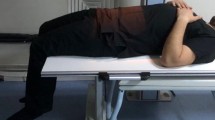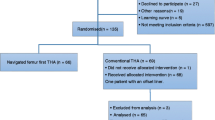Abstract
Introduction
Acetabular cup version is crucial for successful total hip arthroplasty (THA). Many methods have been described for measurement of cup version angle. The aim of this study is to assess the accuracy of five commonly used methods for measurement of acetabular cup version in plain antero-posterior views of the pelvis and hip.
Material and methods
Sixty primary THA cases were subjected postoperatively to plain A-P of the pelvis (AP-P), A-P view of the hip (AP-H), and computed tomography (CT) imaging. The acetabular cup version was measured in AP-P and AP-H by five methods (Lewinnek, Widmer, Hassan et al., Ackland et al., and Liaw et al.). These measurements were compared to the CT measurement.
Results
All plain X-ray methods showed no significant differences from the CT, except those of Hassan et al. in AP-H, and Widmer and Ackland et al. in AP-P.
Conclusions and recommendations
For measurement of acetabular cup version angle, we recommend the use of Lewinnek and Liaw et al. methods both in AP-P and in AP-H, while Hassan et al.’s method is recommended in AP-P only, and Widmer and Ackland et al.’s methods in AP-H only.








Similar content being viewed by others
References
Lewinnek GE, Lewis JL, Tarr R et al (1978) Dislocations after total hip-replacement arthroplasties. J Bone Joint Surg Am 60(2):217–220
Ali Khan MA, Brakenburry PH, Reynolds ISR (1981) Dislocations following total hip replacement. J Bone Joint Surg Br 63(2):214–218
Paterno SA, Lachiewicz PF, Kelley SS (1997) The influence of patient-related factors and the position of the acetabular component on the rate of dislocation after total hip replacement. J Bone Joint Surg Am 79(8):1202–1210
Barrack RL (2003) Dislocation after total hip arthroplasty: implant design and orientation. J Am Acad Orthop Surg 11(2):89–99
Pierchon F, Pasquier G, Cotten A et al (1994) Causes of dislocation of total hip arthroplasty CT study of component alignment. J Bone Joint Surg Br 76(1):45–48
Biedermann R, Tonin A, Krismer M et al (2005) Reducing the risk of dislocation after total hip arthroplasty the effect of orientation of acetabular component. J Bone Joint Surg Br 87(6):762–769
Sadhu A, Nam D, Coobs BR et al (2017) Acetabular component position and the risk of dislocation following primary and revision total hip arthroplasty: a matched cohort analysis. J Arthroplast 32(3):987–991
Fujishiro T, Hiranaka T, Hashimoto S et al (2016) The effect of acetabular and femoral component version on dislocation in primary total hip arthroplasty. Int Orthop 40(4):697–702
D’Lima DD, Urquhart AG, Buehler KO et al (2000) The effect of the orientation of the acetabular and femoral components on the range of motion of the hip at different head-neck ratios. J Bone Joint Surg Am 82(3):315–321
Barrack RL, Lavernia C, Ries M et al (2001) Virtual reality computer animation of the effect of component position and design on stability after total hip arthroplasty. Orthop Clin N Am 32(4):569–577
Kummer FJ, Shah S, Iyer S et al (1999) The effect of acetabular cup orientations on limiting hip rotation. J Arthroplast 14(4):509–513
McCarthy TF, Alipit V, Nevelos J et al (2016) Acetabular cup anteversion and inclination in hip range of motion to impingement. J Arthroplast 31(9 Suppl):264–268
Ezquerra L, Quilez MP, Perez MA et al (2017) Range of movement for impingement and dislocation avoidance in total hip replacement predicted by finite element model. J Med Biol Eng 37(1):26–34
Kennedy JG, Rogers WB, Soffe KE et al (1998) Effect of acetabular component orientation on recurrent dislocation, polyethylene wear, pelvic osteolysis and component migration. J Arthroplast 13(5):530–534
Idrissi ME, Elibrahimi A, Shimi M et al (2016) Acetabular component orientation in total hip arthroplasty: the role of acetabular transverse ligament. Acta Ortop Bras 24(5):267–269
Hambright D, Hellman M, Barrack R (2018) Intra-operative digital imaging: assuring the alignment of components when undertaking total hip arthroplasty. Bone Joint 100 B(1 supple A):36–43
Small T, Krebs V, Molloy R et al (2014) Comparison of acetabular shell position using patient specific instruments vs. standard surgical instruments: a randomized clinical trial. J Arthroplast 29(5):1030–1037
Olivecrona H, Weidenhielm L, Olivecrona L et al (2004) A new CT method for measuring cup orientation after total hip arthroplasty a study of 10 patients. Acta Orthop Scand 75(3):252–260
WidmerKH (2004) A simplified method to determine acetabular cup anteversion from plain radiographs. J Arthroplast 19(3):387–390
Ackland MK, Bourne WB, Uhthoff HK (1986) Anteversion of the acetabular cup measurement of angle after total hip replacement. J Bone Joint Surg Br 68(3):409–413
Hassan DM, Johnston GH, Dust WN et al (1995) Radiographic calculation of anteversion in acetabular prostheses. J Arthroplasty 10(3):369–372
Liaw CK, Hou SM, Yang RS et al (2006) A new tool for measuring cup orientation in total hip arthroplasties from plain radiographs. Clin Orthop Relat Res 451(10):134–139
Bachhal V, Jindal N, Saini G et al (2012) A new method of measuring acetabular cup anteversion on simulated radiographs. Int Orthop 36:1813–1818
Derbyshire B, Diggle PJ, Ingham CJ et al (2014) A new technique for radiographic measurement of acetabular cup orientation. J Arthroplast 29:369–372
Boyle MJ, Yassaie O, Grieve PP et al (2013) Reliability of two-dimensional computed tomography for measuring hip anatomy. J Orthop Surg (Hong Kong) 21(1):28–31
Delagrammaticas DE, Alvi HM, Kaat AJ et al (2018) Quantitative effect of pelvic position on radiographic assessment of acetabular component position. J Arthroplast 33(2):608–614
Nho JH, Lee YK, Kim HJ et al (2012) Reliability and validity of measuring version of the acetabular component. J Bone Joint Surg Br 94(1):32–36
Author information
Authors and Affiliations
Corresponding author
Ethics declarations
This study was approved by the institutional review board (ethical committee) of our institution. Informed consent was obtained from the patients following the guidelines set forth by our institution and by the Declaration of Helsinki and Good Clinical Practice. The consent included approval of the patients to undergo post-operative CT.
Conflict of interest
The authors declare that they have no conflict of interest.
Additional information
Level of Evidence: Level III
Rights and permissions
About this article
Cite this article
Alzohiry, M.A., Abdelnasser, M.K., Moustafa, M. et al. Accuracy of plain antero-posterior radiographic-based methods for measurement of acetabular cup version. International Orthopaedics (SICOT) 42, 2777–2785 (2018). https://doi.org/10.1007/s00264-018-3984-x
Received:
Accepted:
Published:
Issue Date:
DOI: https://doi.org/10.1007/s00264-018-3984-x




